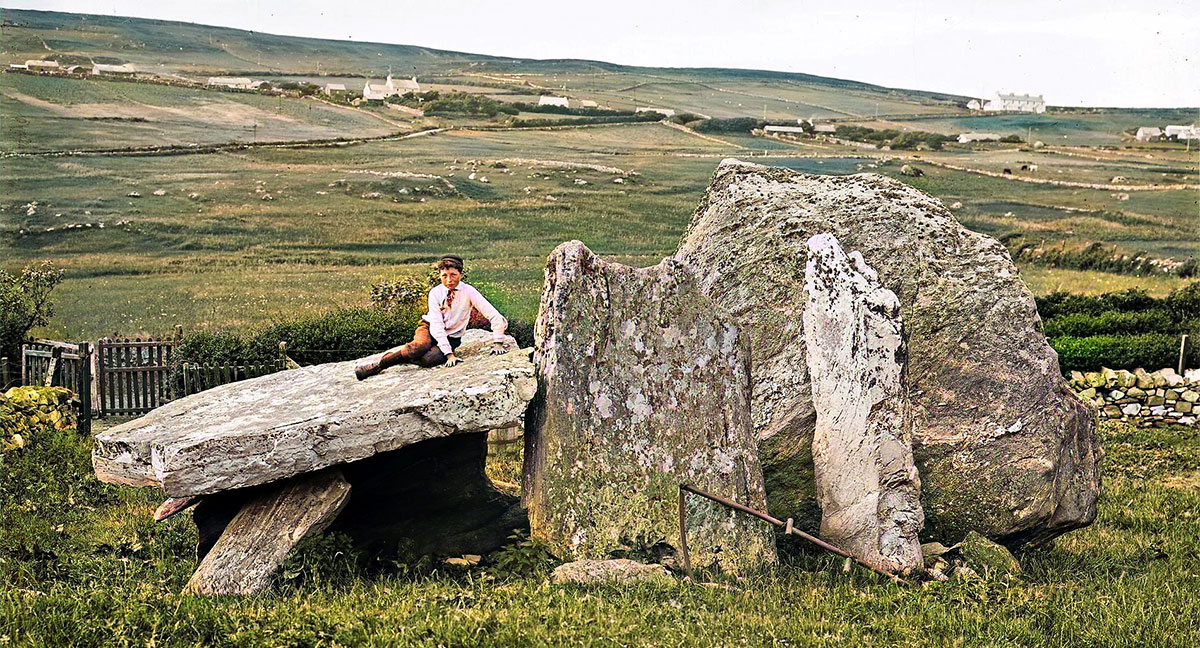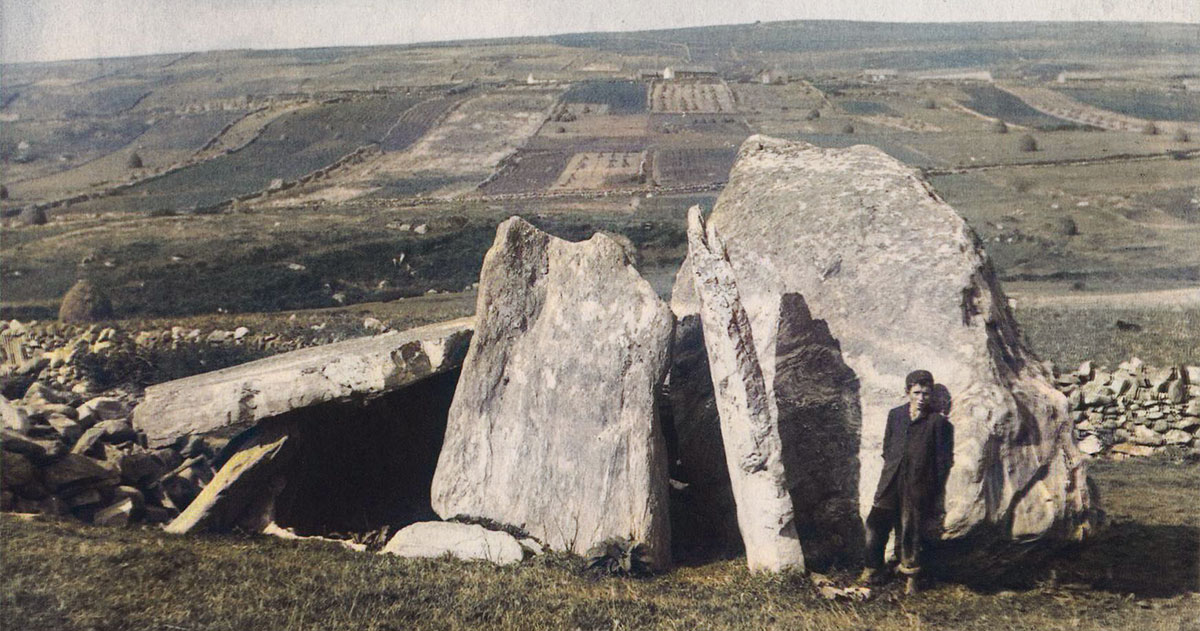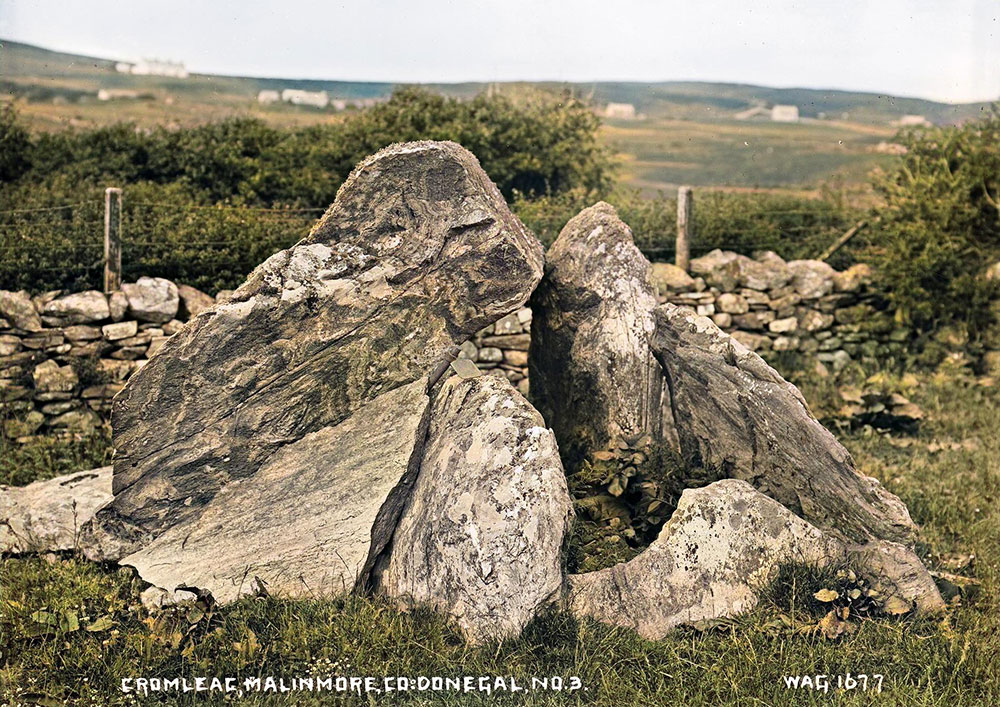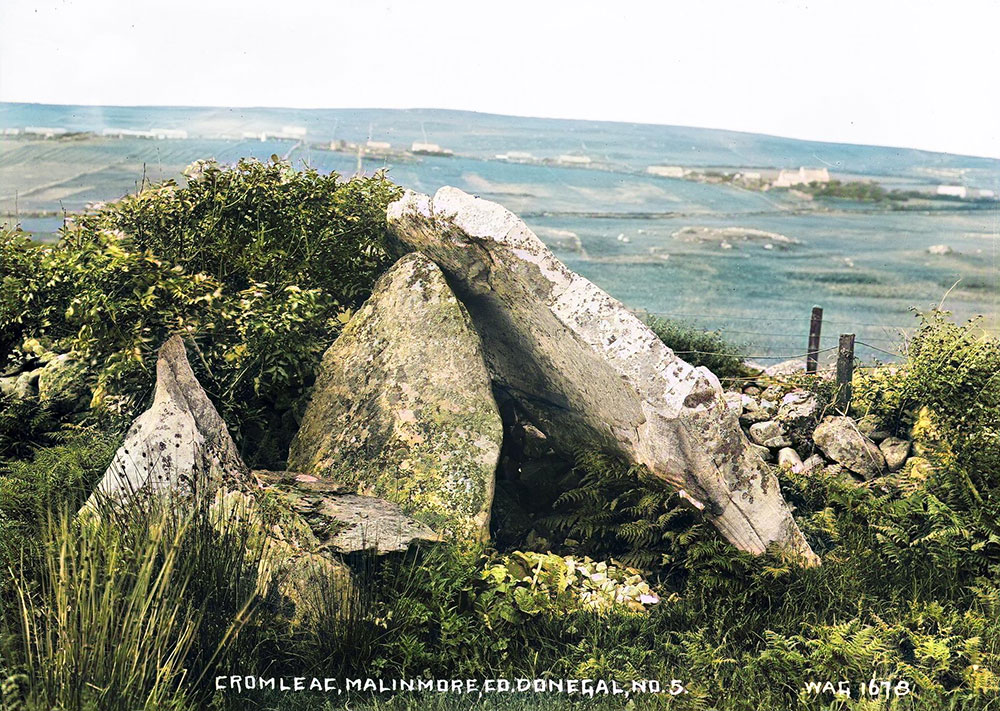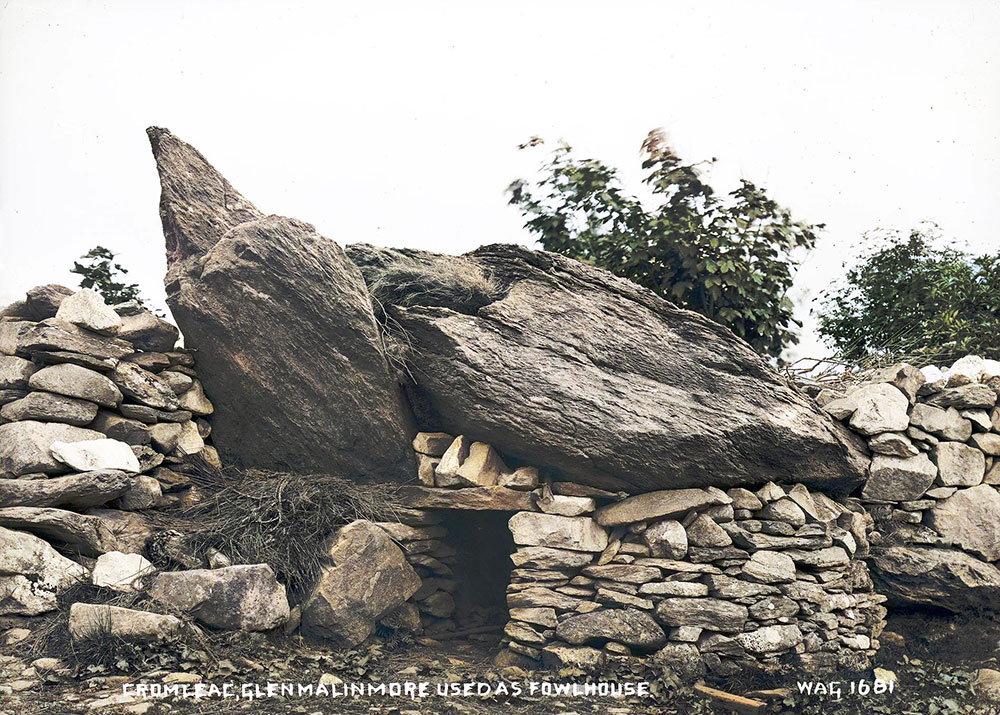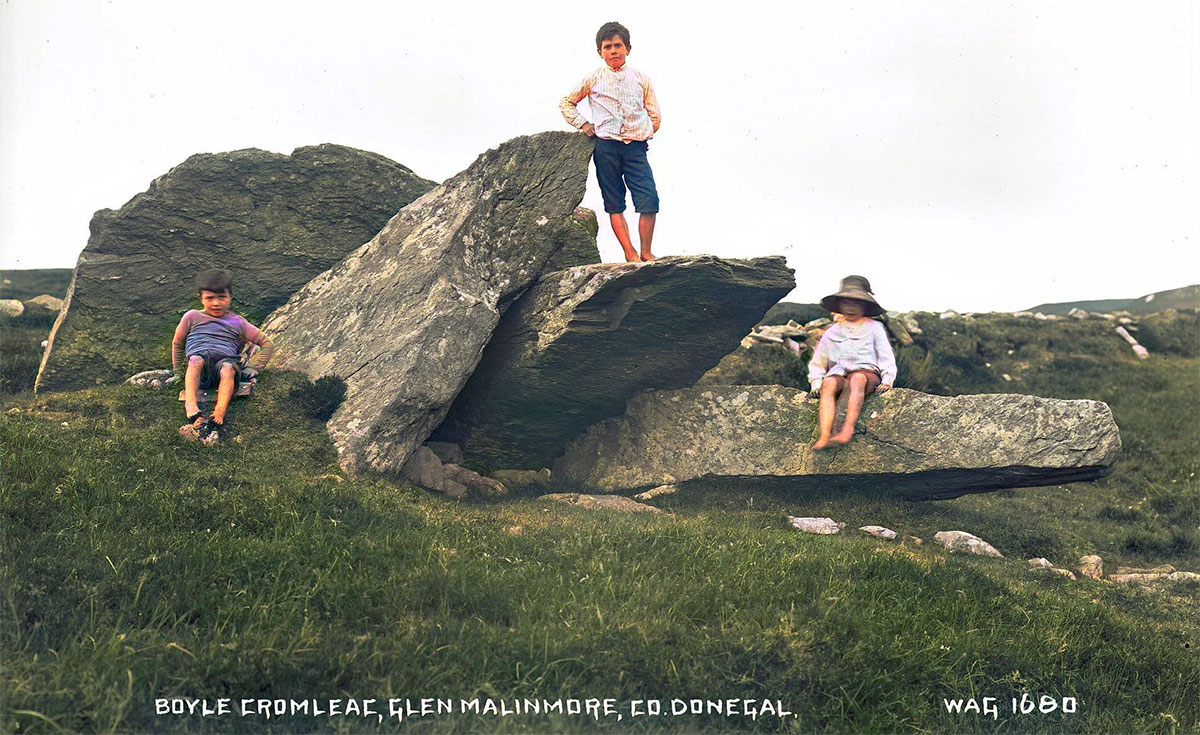The Malin More dolmens
This, the westernmost of the seven megalithic tombs in this townland, is 900 meters southwest of the last ( Donegal 90 ). It stands in pasture reclaimed from the bog on the floor of the valley opening onto the north end of Malin Bay, which is 500 meters to the west.
There is a good outlook from the site to the west and north out to sea and to the east along the valley floor, but steeply rising ground nearby, the lowermost slopes below Leahan Mountain, restrict the view to the south and south-east.
The monument consists of a row of six megalithic chambers ( DG089-008 / 001 / 002 / 003 / 004 /0 05- ) standing at irregular intervals over a distance of 100 meters. They are in two separate fields, three in each, just south of a narrow road and are here numbered 1 to 6 from west to east. The four intermediate chambers are in a line, running more or less east to west, c. 5 meters north of and parallel to a line linking the larger terminal chambers. Chamber Nos. 1, 2, 3 and 6 are portal tomb chambers; No. 5, though very ruined, seems also to have been one, but the original design of No. 4 is uncertain.
The orientations of the four portal tomb chambers are as follows: No. 1 faces east-northeast; No. 2 faces south-southeast; No. 3 faces north; and No. 6 faces east. The orientation of No. 4 is uncertain, but in its present state it seems to have faced east. If, as suggested, the remains at No. 5 are those of a portal tomb chamber, it would have faced either east or west when intact.
The distances between the chambers from west to east are 12 meters, 16 meters, 9 meters, 14 meters and 30 meters. The comparatively large gap between Nos. 5 and 6 suggests there may have been a further chamber between them. If there was such a chamber it may have fallen victim to the construction of the road adjacent to the complex.
Thomas Fagan ( 1845-8 ), who visited the site in 1847, refers to the existence of seven chambers but provides details of only those numbered 1, 3, 4, 5 and 6 here. He claimed that the chambers had stood in one long cairn that he estimated originally measured 100 yards ( c. 91 meters ) east to west and 20 yards ( c. 18 meters ) north to south.
However, it was 'defaced' and 'partly under tillage and fences' when he saw it. A small, low, stony mound, referred to below, survives alongside the easternmost chamber ( No. 6 ) and appears to be the remnant of a cairn. Apart from this, there is a light scatter of partly buried stones over much of the eastern half of the site, but excavation would be required to determine whether these represent an ancient cairn.
The Board of Works carried out work at this site toward the end of the 19th century, but the annual reports of that body provide little information about its nature and extent. Borlase's ( 1897, 244-8 ) charge that major alterations were made to the two larger chambers ( Nos. 1 and 6 ) is considered below.
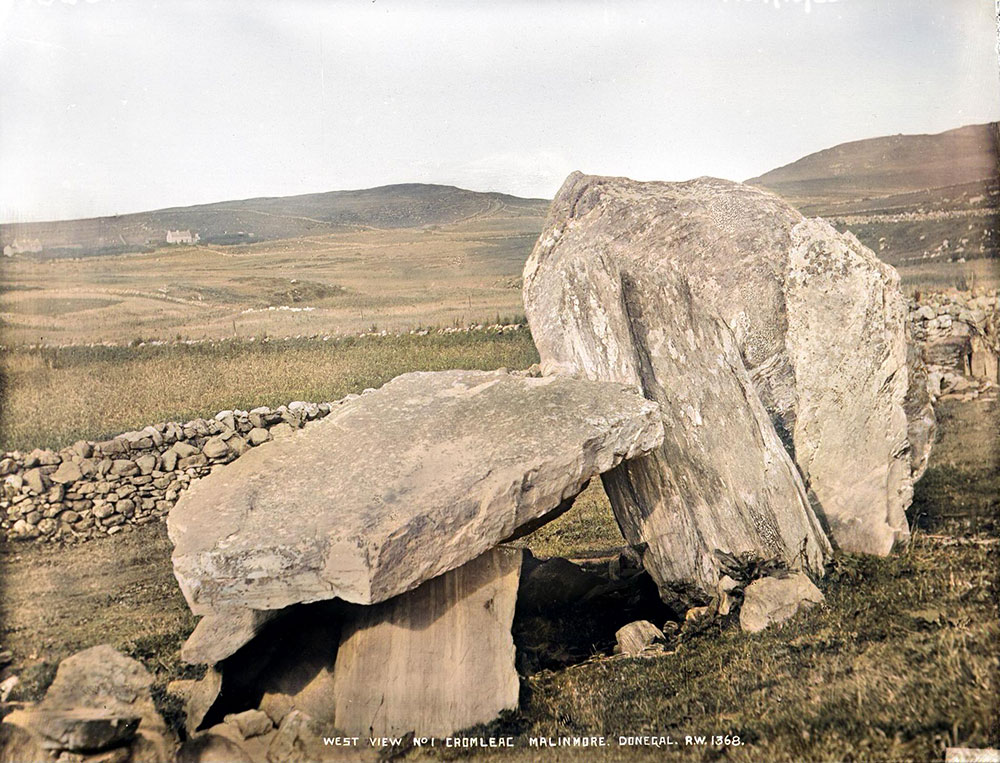
The chambers
No. 1:— The entrance to this chamber, at the east-northeast, is flanked by two longitudinally set portal-stones, in front of each of which is a set stone. The stone in front of the southern portal-stone is a tall pillar-like one, and the one in front of the northern portal-stone is very low and may be just the stump of a taller stone. The southern portal-stone, also tall, is intact. However, the northern one is broken, and only the stump remains in place. The detached part of this stone lies prostrate immediately to the north of the stump.
A single sidestone forms the north side of the chamber. There are two side-stones on the south side: a small stone beside the portal-stone and a large one to the west of it. Outside the adjacent ends of the southern portal-stone and the small sidestone beside it is a low stone, 0.4 meters high. It is not clear whether this is a structural stone.
The chamber is closed by an inward-leaning backstone set between the sidestones. A large pad-stone or corbel in a sloping position rests against the south end of the backstone, and another lies above its north end. A subsidiary roofstone covers that part of the chamber behind the portal-stones.
The main roofstone of the chamber lies displaced in front of the portal-stones. Measured as it stands, it is c. 3.3 meters long and 3 meters high. What appears to have been the front end of the roofstone when in place above the chamber now rests directly on the ground. This, the heavier end of the stone, is c. 1.2 meters thick. It lessens to c. 0.8m at the opposite, now the skyward, end.
The chamber, measured from the backstone to the outer ends of the portal-stones, is 3.2 meters long. It is c. 2 meters wide immediately behind the portal-stones and narrows to 1.7 meters at the back. It should be noted that rising ground level to the south of the chamber obscures the lower levels of the structure on the main sectional drawing.
The stone in front of the southern portal-stone leans southward slightly. It is set transversely to the long axis of the portal- stone and is 2.4 meters high. The low stone in front of the northern portal-stone is set slightly askew to it and is 0.5 meters long, 0.1 meters thick and 0.2 meters high. The two portal-stones are 1.15 meters apart at their outer ends. The southern one, which is slightly overlapped by the small sidestone behind it, is 2.4 meters high.
The stump of the northern portal-stone, set inside the line of the sidestone behind it, is 0.5 meters high. A pecked line on the plan indicates a vertical split in this stone. The detached part of this stone is 2.6 meters long. Thus, when intact, this portal-stone would have been c. 3 meters high.
The northern sidestone decreases in height from 2 meters at its outer end to c. l meter at its inner end. It leans against the edge of the backstone. This inward lean is accentuated by the slight concavity of its inner face. The outer one of the two sidestones on the south side of the chamber is 0.5 meters long, 0.1 meter thick and 0.4 meters high measured at its inner face.
The inner sidestone at this side leans inward. It is clear that a piece, size unknown, has been broken from the top of this stone. It is 0.3 meters high at its outer end, rising to 0.5 meters at its inner end. The backstone is gabled in outline and 1.15 meters high.
The corbel or pad-stone leaning against the southern edge of the last also leans against the adjacent sidestone. The base of the corbel is on the ground, and it rises just above the top of the backstone. The corbel measures 1.4 meters by 1.1 meter and is 0.3 meters thick. The corbel or pad-stone above the north end of the backstone rests in a more or less horizontal position on the southern corbel and on the northern sidestone. It measures 1.2 meters by lm by 0.1 meter thick.
The subsidiary roofstone is 2.85 meters long east to west, narrows from 2.1 meters wide at the front to 1.4 meters near its opposite end, and is 0.3 meters thick. It rests on the northern sidestone and on both corbels and slopes down from front to back.
A small stone is wedged between the northern end of the backstone and the northern sidestone. This is shown on the cross-section accompanying the plan. Another small stone wedged between the top of the broken sidestone at the south and the southern end of the backstone is also shown on the sectional drawing. A third small stone, not on plan or section, is wedged between the roofstone and the northern edge of the northern corbel. This measures 0.2 meters by 0.15 meter by 0.1 meter thick.
Borlase ( 1897, 245 ) claimed that the Board of Works constructed the roofed part of the chamber behind the portal-stones. This claim may have had its origins in his reliance on a brief and imprecise earlier account of the monument ( N. Moore 1872, 521-2 ), which seems to have led him to the erroneous belief that the roofstone now in place behind the portal-stones had originally rested on the tall stones at the front ( east end ) of the structure.
Fagan's account of the monument, the earliest available, describes it as 10 feet ( c. 3.05 meters ) long, 4-51/2 feet ( c. 1.2-1.7 meters ) wide and 2-4 feet ( c. 0.6-1.2 meters ) high. It is clear from his account that the front of the monument was then as it is now. Of that part of the monument behind the portal-stones, he observed that the 'western part of the grave is covered by a flag 10 feet ( c. 3.05 meters ) long, 6-7 feet ( c. 1.8-2.15m ) broad and l-11/2 feet ( c. 0.3-0.45 meters ) thick', measurements that accord well with those of the subsidiary roofstone.
It appears from this that structurally the monument is now much as it was before the Board of Works attended to the site. We can only surmise on the nature of the work that was undertaken by the Board. That it may have proved necessary to stabilise the roofed part of the structure is suggested by the presence of small wedge stones mentioned above. One of these is wedged against the broken top of the western sidestone, so it at least seems to be a late feature.
According to Fagan ( 1845-8 ), a large slab lay prostrate on some small stones just beyond the west end of the chamber. Just north of this was another, which supported a smaller one. Fagan considered the two large slabs to be tombstones. He seems to have regarded them as one burial monument, hence, it appears, his claim that there were seven structures at this site. There is no trace of the slabs referred to by Fagan.
He also noted that there was a slab on top of the prone upper part of the northern portal-stone. This too is now gone. Norman Moore ( 1872, 521 ) observed that earth and small stones hid part of the west end of the structure. This is no longer the case, and it may be that the Board of Works removed them and perhaps some of the large slabs noted by Fagan.
No. 2:— The entrance to this small chamber is at the south-southeast between two portal-stones. The western portal-stone is broken, and only its stump remains. The sides of the chamber are formed by single stones set outside the lines of the portal-stones. It is closed by a stone set between the ends of the sidestones.
A roofstone has slipped westward and now rests on a slab, possibly a piece detached from its underside, which itself rests on the western sidestone. The portal-stones are 0.65 meters apart. The stump of the western one is 0.15 meters high. The intact eastern one is 1.2 meters high. This rises 0.5 meters above the outer end of the eastern sidestone, which leans against it. This sidestone is 0.7 meters high at its outer end, from where it declines to 0.15 meters at the inner end.
The western sidestone slightly overlaps the stump of the adjacent portal-stone but does not touch it. It does, however, lean against the backstone. It is 0.3 meters high. The upright backstone, measured at its inner face, increases in height from 0.2 meters at its eastern edge to 0.35 meters at the western. The appearance of this stone suggests that a piece may have been detached from its top. Ground level outside the backstone is 0.2 meters below that in the chamber.
The displaced roofstone measures 1.8 meters by 1.4 meters by 0.3 meters thick. The slab between it and the top of the western sidestone measures 1.7 meters by at least 0.6 meters and is 0.15 meters in maximum thickness. A stone, 0.7 meters by 0.5 meters by 0.4 meters ( not on plan ), which does not appear to have formed part of the structure, lies between the portal-stones.
In addition some small stones lie in the chamber. This chamber, when intact, would have been just under 2 meters long. It narrows slightly from 1.05 meters just inside the portal-stones to 0.9 meters at the back.

